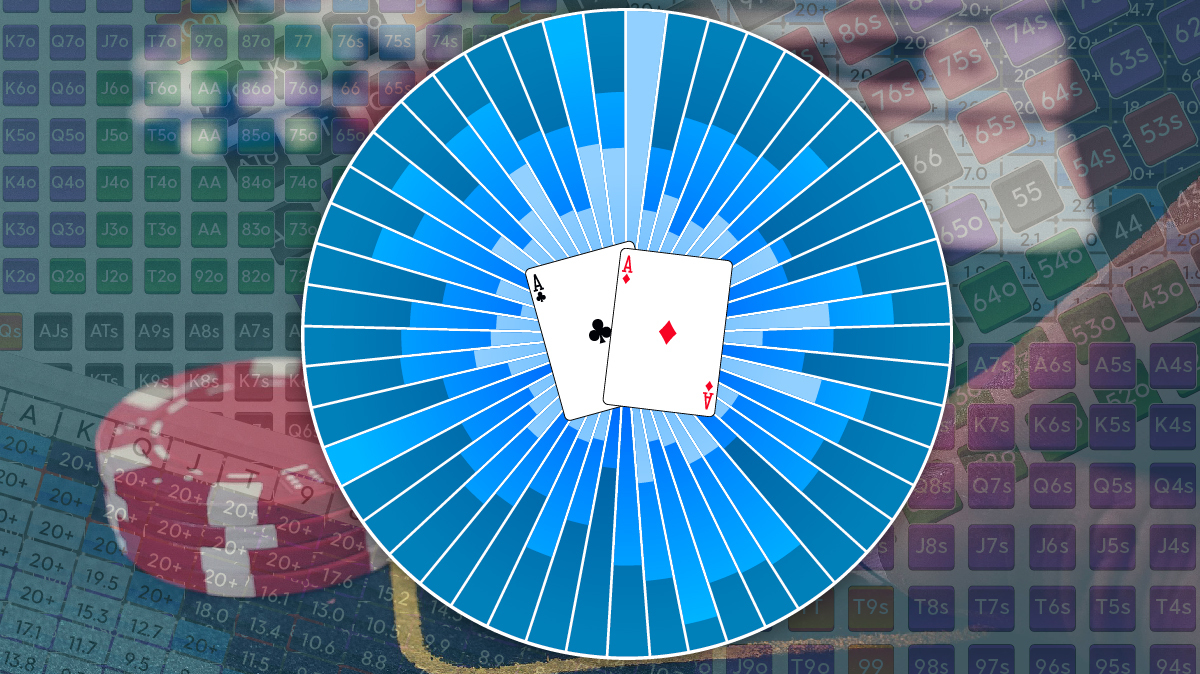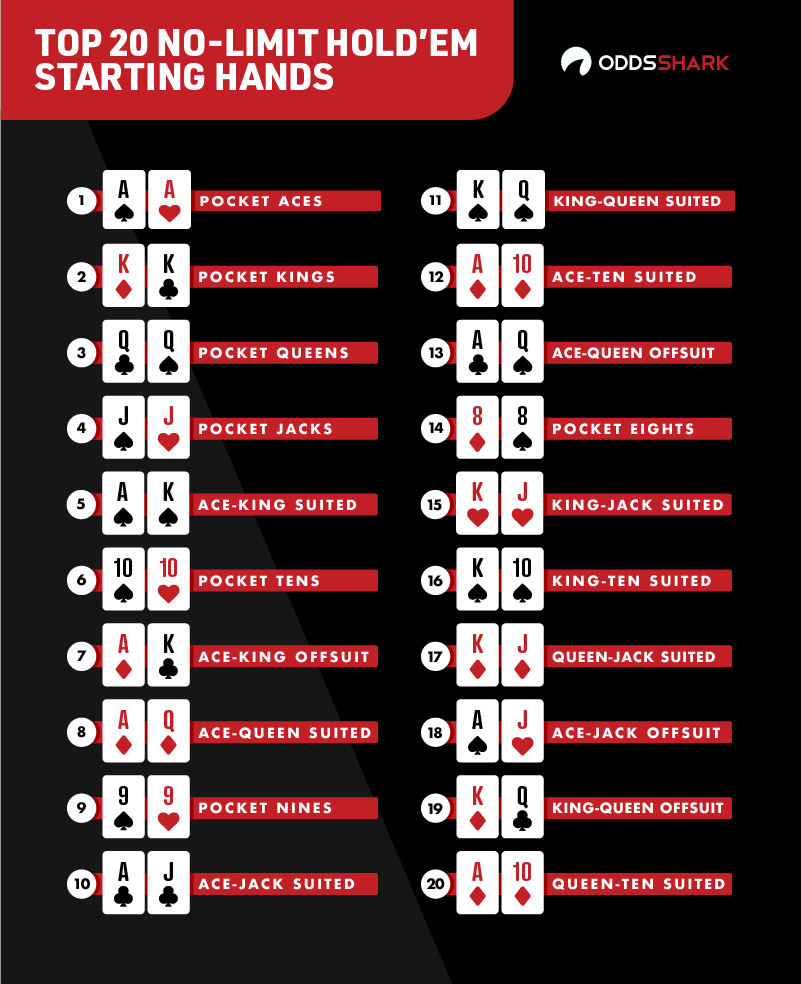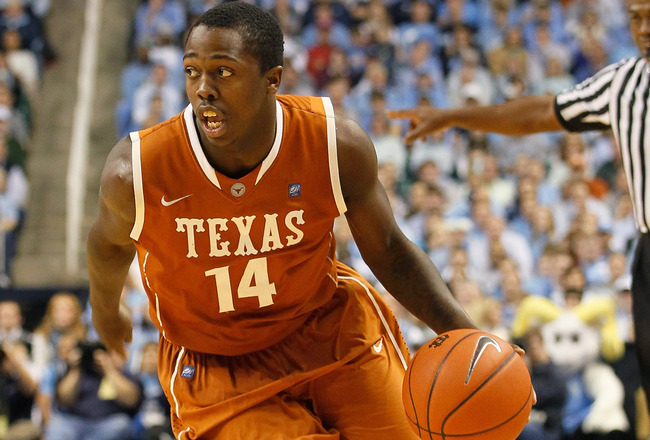How Many Players Texas Holdem
- Pineapple - Crazy Pineapple - Crazy Pineapple Hi-Lo
So Texas Hold’em could be played by up to 22 players (44 player cards, 3 burn cards, and 5 community cards) sitting at the same table (you better have a big table).
- Remember, poker is a battle royale. When you prepare to don your battle armor, be.
- Texas Hold'em is usually played with no ante, but with blinds. When there are more than two players, the player to dealer's left places a small blind, and the next player to the left a big blind. The big blind is equal to the minimum bet and the small blind is typically half that amount.
- The playing chips used when playing Texas Holdem depends on the players available at each table. For a table of around fifty players, then 75 chips can be issued to each player or when there are around 40 players at the table, the chips issued to each player can be less than 5 colors.
- This brings the total number of chips starting out on the table to 360 poker chips (36 X 10 players). As mentioned, players will often rebuy (sometimes many times) and players may be allowed to buy-in for more than 100 BB’s. This means we have to consider the extra poker chips needed for the game. The starting value of the chips on the table is $2000 (10 players X $200).
Introduction
Texas Hold'em is a shared card poker game. Each player is dealt two private cards and there are five face up shared (or 'community') cards on the table that can be used by anyone. In the showdown the winner is the player who can make the best five-card poker hand from the seven cards available.
Since the 1990's, Texas Hold'em has become one of the most popular poker games worldwide. Its spread has been helped firstly by a number of well publicised televised tournaments such as the World Series of Poker and secondly by its success as an online game. For many people nowadays, poker has become synonymous with Texas Hold'em.

This page assumes some familiarity with the general rules and terminology of poker. See the poker rules page for an introduction to these, and the poker betting and poker hand ranking pages for further details.
Players and Cards
From two to ten players can take part. In theory more could play, but the game would become unwieldy.
A standard international 52-card pack is used.
The Deal and Betting
Texas Hold'em is usually played with no ante, but with blinds. When there are more than two players, the player to dealer's left places a small blind, and the next player to the left a big blind. The big blind is equal to the minimum bet and the small blind is typically half that amount. When there are only two players (a 'heads-up' game), the dealer places the small blind and the non-dealer the big blind.
The cards are shuffled and cut, the dealer 'burns' one card and then deals the cards one at a time face down until each player has two cards. These are known as the player's hole cards or pocket cards. Players may look at their two hole cards and must not show them to any other player.
The first betting round is begun by the player to the left of the big blind. The blinds count as bets, so the small blind need only pay the difference between the blinds to call. The big blind player acts last and is allowed to raise, even if the other active players have all called.
After the first betting round the dealer burns one card and deals three cards face up to the table. These three cards are known as the flop. There is then a second betting round begun by the first active player to the left of the dealer seat.
When the second betting round is complete, the dealer burns a card and then deals one card face up to the table. This card is known as the turn or fourth street. There is then a third betting round, again begun by the first active player to the left of the dealer seat.
After the third betting round the dealer burns another card and deals one more card face up - the river or fifth street. There is fourth and final round of betting before the showdown, again begun by the first active player to the left of the dealer seat.
In a fixed-limit or spread-limit game, any betting round that has more than two active players at the start is normally limited to one bet plus three (sometimes four) raises. In the first (pre-flop) betting round the big blind counts for this purpose as the first bet. If a betting round begins with only two active players, there is no limit on the number of raises.
In limit poker, the betting limits are usually doubled before the third betting round. So for example a $10-$20 game would typically have blinds of $5 and $10, bets of $10 in the first two rounds and bets of $20 in the last two.
The Showdown
Active players show their hands in clockwise order, beginning with the player who was the last to bet or raise in the final betting round. If everyone checked in the final betting round, the first active player to the left of the dealer seat is the first to show. See the betting and showdown page for further details.
Each player makes the best possible five-card poker hand from the seven available cards: the player's two hole cards and the five face-up table cards, which are known as the board. This can be in any combination: both hole cards with three from the board, one hole card with four from the board, or just the board cards without using the hole cards at all, which is known as playing the board.

Note that:
- For a hand to be considered for winning the pot, the player must show both hole cards, even if only one or neither of them is used to make the best hand.
- The cards speak for themselves: the best hand is entitled to win the pot if shown, even if the owner does not realise that it is the best hand.
- As always, poker hands consist of just five cards. The two unused cards have no bearing on whether one hand is better than another.
Example. On the board is A-Q-Q-9-6. Player A has K-9; player B has 9-6; player C has 9-3. This is a three-way tie, since all three players have Q-Q-9-9-A as their best hand. The pot is split equally between A, B and C.
Strategy
Because of its great popularity as a tournament and online game, much has been written about the strategy of Texas Hold'em.
The Poker Strategy page provides a list of sites with useful Texas Hold'em Strategy articles.
The Poker Books page reviews a couple of good books about how to play Texas Hold'em.
Variations
The game described above is Texas Hold'em as played formally in public card rooms. When it is played at home, the same procedure can be used, but in some informal games the burning of cards is omitted, and the five community cards are dealt face down to the table at the start. Three of these cards are turned face up after the first betting round, one after the second and one after the third. The result is similar to the formal game, but there is an increased risk that a player might, by accident or by cheating, learn the identity of some of the table cards before they are officially exposed.
The practice of dealing the community cards to the table at the start and turning them face up later is commonly found in community card poker games with more complex layouts, such as Iron Cross and Tic-Tac-Toe. Several of these are listed on the Poker Variants page.
Pineapple
This is played the same way as Texas Hold'em, except that each player is initially dealt three hole cards and must discard one of them before the first round of betting.
Crazy Pineapple
As in Pineapple, each player is dealt three cards, but in Crazy Pineapple they are kept until after the second betting round. Each active player must discard one card immediately before the fourth board card (the turn) is dealt.
Crazy Pineapple Hi-Lo 8 or Better
Crazy Pineapple is often played in such a way that the pot is shared between the players with the highest and lowest hands. The deal and betting are exactly as in Crazy Pineapple. At the showdown, as well as making their best hand, each active player makes the lowest possible hand from their seven cards. When making a low hand, the five cards must all be of different ranks, the aces count as low, straights and flushes do not count, and no card can be higher than an 8. So the best low hand is A-2-3-4-5 and the worst is 8-7-6-5-4. Cards are compared from the top down, so 7-5-4-3-2 is better than 7-6-3-2-A because the 5 is lower than the 6. Players can use a different selection of cards for their high hand and their low hand.
The pot is split equally between the highest hand and the lowest hand. If none of the active players qualifies for low (which will automatically be the case if there are three cards higher than 8 on the board), then the player with the highest hand wins the whole pot.
Irish
This Texas Hold'em variant is similar to Crazy Pineapple, but each player is initially dealt four hole cards. These can all be kept until the end of the second round of betting. Before the fourth board card (the turn) is dealt, each active player must discard two of their hole cards, keeping just two for the turn and river.
In the poker game of Texas hold 'em, a starting hand consists of two hole cards, which belong solely to the player and remain hidden from the other players. Five community cards are also dealt into play. Betting begins before any of the community cards are exposed, and continues throughout the hand. The player's 'playing hand', which will be compared against that of each competing player, is the best 5-card poker hand available from his two hole cards and the five community cards. Unless otherwise specified, here the term hand applies to the player's two hole cards, or starting hand.
Essentials[edit]
There are 1326 distinct possible combinations of two hole cards from a standard 52-card deck in hold 'em, but since suits have no relative value in this poker variant, many of these hands are identical in value before the flop. For example, A♥J♥ and A♠J♠ are identical in value, because each is a hand consisting of an ace and a jack of the same suit.
Therefore, there are 169 non-equivalent starting hands in hold 'em, which is the sum total of : 13 pocket pairs, 13 × 12 / 2 = 78 suited hands and 78 unsuited hands (13 + 78 + 78 = 169).
These 169 hands are not equally likely. Hold 'em hands are sometimes classified as having one of three 'shapes':
How Many Players For Texas Hold'em
- Pairs, (or 'pocket pairs'), which consist of two cards of the same rank (e.g. 9♠9♣). One hand in 17 will be a pair, each occurring with individual probability 1/221 (P(pair) = 3/51 = 1/17).
- Alternative means of making this calculation
- First Step
- As confirmed above.
- There are 1326 possible combination of opening hand.
- Second Step
- There are 6 different combos of each pair. 9h9c, 9h9s, 9h9d, 9c9s, 9c9d, 9d9s. Therefore, there are 78 possible combinations of pocket pairs (6 multiplied by 13 i.e. 22-AA)
- To calculate the odds of being dealt a pair
- 78 (the number of any particular pair being dealt. As above) divided by 1326 (possible opening hands)
Microsoft Edge Texas Holdem Poker
- 78/1326 = 0.058 or 5.8%
- Suited hands, which contain two cards of the same suit (e.g. A♣6♣). 23.5% of all starting hands are suited.
Texas Holdem No Sign Up
Probability of first card is 1.0 (any of the 52 cards)Probability of second hand suit matching the first:There are 13 cards per suit, and one is in your hand leaving 12 remaining of the 51 cards remaining in the deck. 12/51=.2353 or 23.5%
- Offsuit hands, which contain two cards of a different suit and rank (e.g. K♠J♥). 70.6% of all hands are offsuit hands
Offsuit pairs = 78Other offsuit hands = 936
It is typical to abbreviate suited hands in hold 'em by affixing an 's' to the hand, as well as to abbreviate non-suited hands with an 'o' (for offsuit). That is,
- QQ represents any pair of queens,
- KQ represents any king and queen,
- AKo represents any ace and king of different suits, and
- JTs represents any jack and ten of the same suit.
Limit hand rankings[edit]
Some notable theorists and players have created systems to rank the value of starting hands in limit Texas hold'em. These rankings do not apply to no limit play.
Sklansky hand groups[edit]
David Sklansky and Mason Malmuth[1] assigned in 1999 each hand to a group, and proposed all hands in the group could normally be played similarly. Stronger starting hands are identified by a lower number. Hands without a number are the weakest starting hands. As a general rule, books on Texas hold'em present hand strengths starting with the assumption of a nine or ten person table. The table below illustrates the concept:

Chen formula[edit]
The 'Chen Formula' is a way to compute the 'power ratings' of starting hands that was originally developed by Bill Chen.[2]
- Highest Card
- Based on the highest card, assign points as follows:
- Ace = 10 points, K = 8 points, Q = 7 points, J = 6 points.
- 10 through 2, half of face value (10 = 5 points, 9 = 4.5 points, etc.)
How Many Players Can Play Texas Holdem
- Pairs
- For pairs, multiply the points by 2 (AA=20, KK=16, etc.), with a minimum of 5 points for any pair. 55 is given an extra point (i.e., 6).
- Suited
- Add 2 points for suited cards.
- Closeness
- Subtract 1 point for 1 gappers (AQ, J9)
- 2 points for 2 gappers (J8, AJ).
- 4 points for 3 gappers (J7, 73).
- 5 points for larger gappers, including A2 A3 A4
- Add an extra point if connected or 1-gap and your highest card is lower than Q (since you then can make all higher straights)
How Many Players In Texas Holdem Poker
Phil Hellmuth's: 'Play Poker Like the Pros'[edit]
Phil Hellmuth's 'Play Poker Like the Pros' book published in 2003.
| Tier | Hands | Category |
|---|---|---|
| 1 | AA, KK, AKs, QQ, AK | Top 12 Hands |
| 2 | JJ, TT, 99 | |
| 3 | 88, 77, AQs, AQ | |
| 4 | 66, 55, 44, 33, 22, AJs, ATs, A9s, A8s | Majority Play Hands |
| 5 | A7s, A6s, A5s, A4s, A3s, A2s, KQs, KQ | |
| 6 | QJs, JTs, T9s, 98s, 87s, 76s, 65s | Suited Connectors |
Statistics based on real online play[edit]
Statistics based on real play with their associated actual value in real bets.[3]
| Tier | Hands | Expected Value |
|---|---|---|
| 1 | AA, KK, QQ, JJ, AKs | 2.32 - 0.78 |
| 2 | AQs, TT, AK, AJs, KQs, 99 | 0.59 - 0.38 |
| 3 | ATs, AQ, KJs, 88, KTs, QJs | 0.32 - 0.20 |
| 4 | A9s, AJ, QTs, KQ, 77, JTs | 0.19 - 0.15 |
| 5 | A8s, K9s, AT, A5s, A7s | 0.10 - 0.08 |
| 6 | KJ, 66, T9s, A4s, Q9s | 0.08 - 0.05 |
| 7 | J9s, QJ, A6s, 55, A3s, K8s, KT | 0.04 - 0.01 |
| 8 | 98s, T8s, K7s, A2s | 0.00 |
| 9 | 87s, QT, Q8s, 44, A9, J8s, 76s, JT | (-) 0.02 - 0.03 |
How Many Players For Texas Holdem
Nicknames for starting hands[edit]
In poker communities, it is common for hole cards to be given nicknames. While most combinations have a nickname, stronger handed nicknames are generally more recognized, the most notable probably being the 'Big Slick' - Ace and King of the same suit, although an Ace-King of any suit combination is less occasionally referred to as an Anna Kournikova, derived from the initials AK and because it 'looks really good but rarely wins.'[4][5] Hands can be named according to their shapes (e.g., paired aces look like 'rockets', paired jacks look like 'fish hooks'); a historic event (e.g., A's and 8's - dead man's hand, representing the hand held by Wild Bill Hickok when he was fatally shot in the back by Jack McCall in 1876); many other reasons like animal names, alliteration and rhyming are also used in nicknames.
Notes[edit]
- ^David Sklansky and Mason Malmuth (1999). Hold 'em Poker for Advanced Players. Two Plus Two Publications. ISBN1-880685-22-1
- ^Hold'em Excellence: From Beginner to Winner by Lou Krieger, Chapter 5, pages 39 - 43, Second Edition
- ^http://www.pokerroom.com/poker/poker-school/ev-stats/total-stats-by-card/[dead link]
- ^Aspden, Peter (2007-05-19). 'FT Weekend Magazine - Non-fiction: Stakes and chips Las Vegas and the internet have helped poker become the biggest game in town'. Financial Times. Retrieved 2010-01-10.
- ^Martain, Tim (2007-07-15). 'A little luck helps out'. Sunday Tasmanian. Retrieved 2010-01-10.